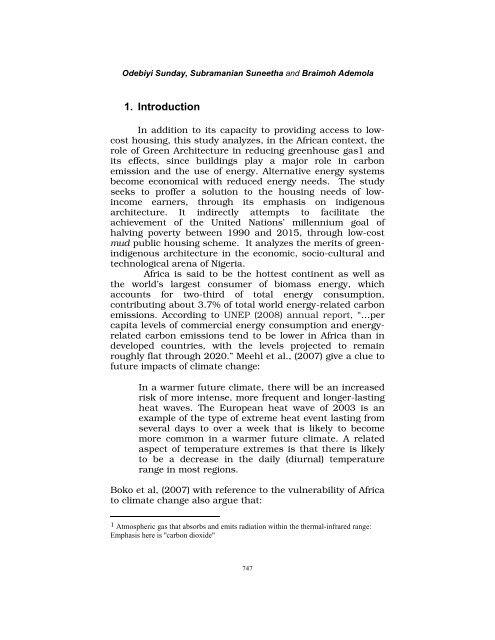Green Architecture: Merits for Africa (Nigerian Case Study)
Green Architecture: Merits for Africa (Nigerian Case Study)
Green Architecture: Merits for Africa (Nigerian Case Study)
Create successful ePaper yourself
Turn your PDF publications into a flip-book with our unique Google optimized e-Paper software.
Odebiyi Sunday, Subramanian Suneetha and Braimoh Ademola<br />
1. Introduction<br />
In addition to its capacity to providing access to lowcost<br />
housing, this study analyzes, in the <strong>Africa</strong>n context, the<br />
role of <strong>Green</strong> <strong>Architecture</strong> in reducing greenhouse gas1 and<br />
its effects, since buildings play a major role in carbon<br />
emission and the use of energy. Alternative energy systems<br />
become economical with reduced energy needs. The study<br />
seeks to proffer a solution to the housing needs of lowincome<br />
earners, through its emphasis on indigenous<br />
architecture. It indirectly attempts to facilitate the<br />
achievement of the United Nations’ millennium goal of<br />
halving poverty between 1990 and 2015, through low-cost<br />
mud public housing scheme. It analyzes the merits of greenindigenous<br />
architecture in the economic, socio-cultural and<br />
technological arena of Nigeria.<br />
<strong>Africa</strong> is said to be the hottest continent as well as<br />
the world’s largest consumer of biomass energy, which<br />
accounts <strong>for</strong> two-third of total energy consumption,<br />
contributing about 3.7% of total world energy-related carbon<br />
emissions. According to UNEP (2008) annual report, “…per<br />
capita levels of commercial energy consumption and energyrelated<br />
carbon emissions tend to be lower in <strong>Africa</strong> than in<br />
developed countries, with the levels projected to remain<br />
roughly flat through 2020.” Meehl et al., (2007) give a clue to<br />
future impacts of climate change:<br />
In a warmer future climate, there will be an increased<br />
risk of more intense, more frequent and longer-lasting<br />
heat waves. The European heat wave of 2003 is an<br />
example of the type of extreme heat event lasting from<br />
several days to over a week that is likely to become<br />
more common in a warmer future climate. A related<br />
aspect of temperature extremes is that there is likely<br />
to be a decrease in the daily (diurnal) temperature<br />
range in most regions.<br />
Boko et al, (2007) with reference to the vulnerability of <strong>Africa</strong><br />
to climate change also argue that:<br />
1 Atmospheric gas that absorbs and emits radiation within the thermal-infrared range:<br />
Emphasis here is ''carbon dioxide''<br />
747

















